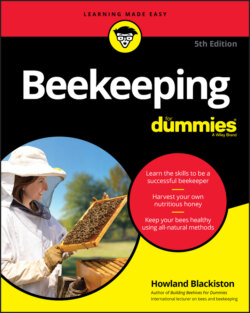Читать книгу Beekeeping For Dummies - Howland Blackiston - Страница 50
Her majesty, the queen
ОглавлениеLet there be no mistake about it — the queen bee is the heart and soul of the colony. There is only one queen bee in a colony. She is the reason for nearly everything the rest of the colony does. The queen is the only bee without which the rest of the colony cannot survive. Without her, your hive is sunk. A good-quality queen means a strong and productive hive. For more information on how to evaluate a good queen, see Chapter 8. And for some real fun, try raising your own queens from your best performing hives. See Chapter 14.
Courtesy of Howland Blackiston
FIGURE 2-5: These are the three types of bees in the hive: worker, drone, and queen.
As a beekeeper, on every visit to the hive you need to determine two things: “Do I have a queen?” and “Is she healthy?”
The queen is the largest bee in the colony, with a long and graceful body. She is the only female with fully developed ovaries. The queen’s two primary purposes are to produce chemical scents that help regulate the unity of the colony and to lay eggs — and lots of them. She is, in fact, an egg-laying machine, capable of producing more than 1,500 eggs a day at 30-second intervals. That many eggs are more than her body weight!
The other bees pay close attention to the queen, tending to her every need. Like a regal celebrity, she’s always surrounded by a flock of attendants as she moves about the hive (see Figure 2-6). Yet, she isn’t spoiled. These attendants are vital because the queen is incapable of tending to her own basic needs. She can neither feed nor groom herself. She can’t even leave the hive to relieve herself. And so her doting attendants (the queen’s court, her retinue) take care of her basic needs while she tirelessly goes from cell to cell doing what she does best: lay eggs.
Courtesy of USDA-ARS
FIGURE 2-6: A queen and her attentive attendants.
The gentle queen bee has a stinger, but it is rare for a beekeeper to be stung by a queen bee. I have handled many queen bees and have never been stung by any of them. In general, queen bees use their stingers only to kill rival queens that may emerge or be introduced in the hive.
The queen can live for two or more years, but replacing your queen after a season or two ensures maximum productivity and colony health. Many seasoned beekeepers routinely replace their queens every year after the nectar flow. This practice ensures that the colony has a new, energetic, and fertile young queen each season. You may wonder why you should replace the queen if she’s still alive. That’s an easy one: As a queen ages, her egg-laying capability slows down, which results in less and less brood each season. Less brood means a smaller colony. And a smaller colony means a lackluster honey harvest for you! For information on how to successfully introduce a new queen, see Chapter 10. For information on how to raise your own queens (now, that’s fun!), see Chapter 14.
As a beekeeper, your job is to anticipate problems before they happen. An aging queen — more than a year old — is something that you can deal with by replacing her after checking her egg-laying, before you have a problem resulting from a poorly performing queen.
